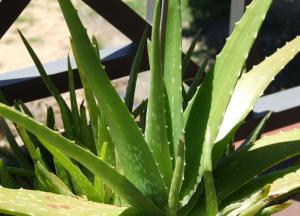Aloe Is Poisonous To Pets

Although Aloe is generally considered to be a healing plant or herbal remedy it can be harmful to pets if ingested. Aloe Latex (Aloe Juice) is a yellowish, bitter liquid that containing Aloin that can be found just under the skin of the Aloe leaf and acts as a powerful laxative. Once ingested, aloin increases symmetrical contraction and relaxation of muscles of the colon inducing bowel movements. Aloin also opens the chloride channels of the colonic membrane preventing the colon from re-absorbing water from the gastrointestinal tract, leading to even softer stools. Aloe latex also has an irritative effect on the large intestines which when combined with its properties as a natural laxative can lead to severe diarrhea, putting the pet at risk for dehydration. The University of Wisconsin confirms this and lists aloe vera as a toxic plant noting that consumption of large amounts of aloe vera latex has caused diarrhea so severe that it resulted in dehydration and electrolyte imbalances. There is also the possibility of contact dermatitis to the mouth, throat, nose and face in animals with sensitive skin or allergies to latex. The ingestion of Aloe by a pet is generally not considered to be life threatening and the symptoms will typically be limited to mild to severe gastrointestinal upset (vomiting, diarrhea), a change in urine color, and tremors. Because aloin can potentially cause uterine contractions, pregnant animals should not be allowed access to areas containing Aloe vera plants.
Avoid further ingestion of the plant and consult a veterinarian. If contact dermatitis is noted flush the area thoroughly with water. Ensure the pet gets plenty of fluids to avoid possible dehydration caused by diarrhea. If the pet is severely dehydrated IV fluid therapy may be required. To alleviate the gastrointestinal upset and diarrhea Kapectolin may be given at a dose rate of 1 to 2 ml/kg four times a day. Kapectolin provides a coating action that protects the stomach lining. Sucralfate may also be used as for gastrointestinal irritation as it reacts with the acids in the stomach to form a paste-like material capable of acting as a barrier between the stomach and its contents. Sucralfate is typically given to dogs weighing more the 60lbs: 1g every 6 to 8 hours; for dogs under 60 lbs: 0.5g every 6 to 8 hours; Cats: 0.25g every 8 to 12 hours to reduce irritation of the stomach and intestines. The prognosis with symptomatic and supportive treatment is good and pets are expected to make a full recovery in 1 to 2 days.
Comments
I am looking up aloe because I just saw a video claiming that it reduces seizures in dogs So far, every website offering information either doesn't specify the part of the aloe plant or they specifically say that it's the outer, white part of the plant that is toxic but that the sticky jell of the inside has health benefits. This site is the first one that specifically identifies the inner portion of the plant as being toxic.
Thank you





